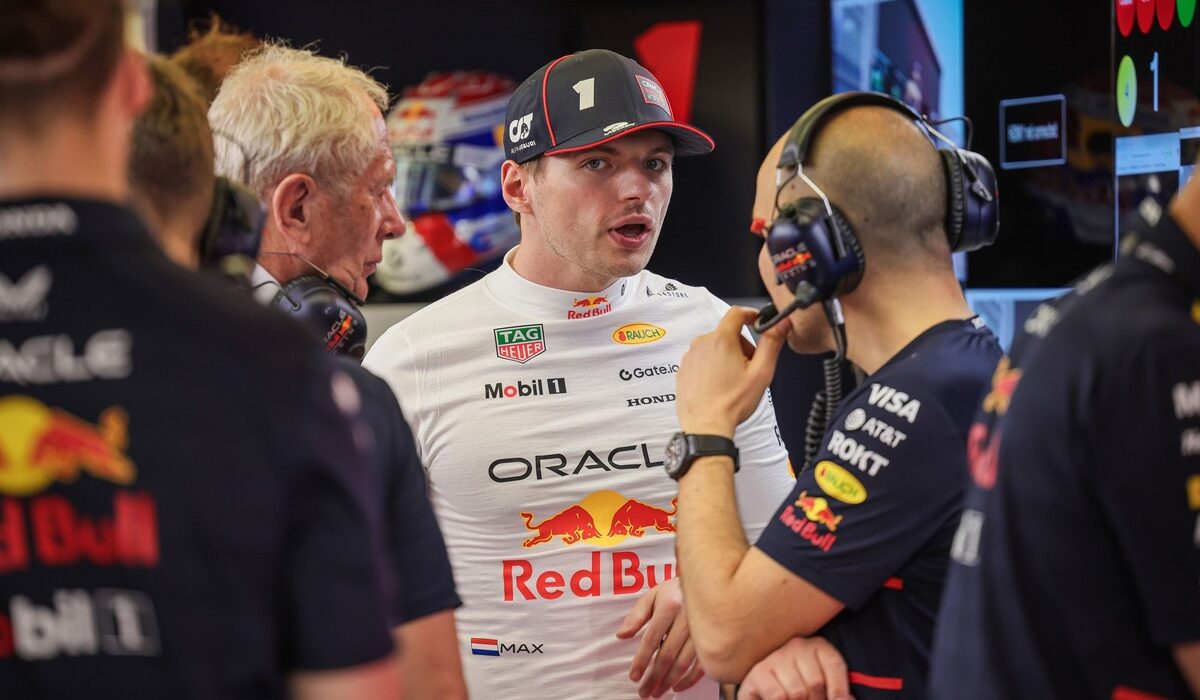On Friday evening at Bahrain International Circuit, the Formula One Management crew busied themselves readying the podium area for the post-race ceremonials. A clutch of glitzy pre-prepared graphics cycled through on the giant screen behind the podium – including one screaming “MAX SECOND WIN OF 2025”.
Based on Red Bull’s current performance trajectory, that one will be sitting on the cloud server for a while yet.
In Bahrain the drivers who grace the podium do not spray the customary champagne but a non-alcoholic effervescent rosewater, Waard. Supposedly it’s easier to launder out of racewear than its alcoholic equivalent.
Not that Red Bull team principal Christian Horner would have drawn succour from this small saving on the dry-cleaning bill, for immediately after the race he cloistered himself with other senior heads of the team – technical director Pierre Wache, chief engineer Paul Monaghan, ‘driver advisor’ Helmut Marko – to pick over the ugly details.
Yuki Tsunoda finishing just three places behind Max Verstappen, on any other day a tick in the merits box, was not on the agenda. For Max had finished sixth, half a minute behind the winner, in a race where he said “everything went wrong that could go wrong” – brake problems, scruffy handling, and poltergeists in the pit equipment.
Max Verstappen, Red Bull Racing
Photo by: Bryn Lennon – Getty Images
As the current ground-effect regulations approach maturity, many teams on the grid – especially towards the front – are finding peak performance trickier to achieve and highly dependent on track characteristics and weather conditions. Red Bull’s car is such a case: quick enough last weekend on a demanding circuit in cool conditions, but almost impossible to balance in Bahrain, where warmer weather combined with an abrasive track surface to keep the RB21 in its box.
On top of that, brake issues which a change of material failed to remedy – and a suspected wiring loom problem in the pit gantry which affected the automated ‘traffic light’ system the team uses to signal drivers when the wheels are tightened and it’s safe to depart. It wasn’t until the lights malfunctioned a second time, when Tsunoda came in shortly after Verstappen, that it became clear Max’s incorrect signal wasn’t just a case of ‘finger trouble’.
Red Bull has already weathered the loss of technical leader Adrian Newey in the past 12 months, although the theme of the official line is that the team didn’t need him anyway. If Verstappen were to trigger the performance clauses in his contract and leave early, Red Bull’s leaders would struggle to sell the same spin all over again.
“Ultimately you can mask it a little through set-up, and we were able to achieve that last weekend at Suzuka,” said Horner in his post-race briefing. “But I think this race has exposed some pitfalls we clearly have that we need to get on top of very quickly.
“We understand where the issues are, it’s introducing the solutions that obviously takes a little more time.”
The brake problems – Verstappen complained of a lack of bite and feel in what is one of a driver’s most important touch points – were unexpected but potentially more easily resolvable than the RB21’s capricious handling characteristics. Horner conceded that one of the obstacles to understanding and resolving the car’s behaviour is that it hasn’t been possible to recreate it accurately in simulation.
Yuki Tsunoda, Red Bull Racing
Photo by: Fadel Senna – AFP – Getty Images
Among Tsunoda’s observations after driving the RB21 for the first time was how much its temperament differed from the simulator.
“The solutions, with what we see in our tools compared with what we’re seeing on track at the moment, aren’t correlating,” said Horner. “That’s what we need to get to the bottom of – why can we not see in our tools what we’re seeing on the circuit?
“When you end up with a disconnect like that you have to unpick it. We have a strong technical team that have produced some amazing cars over the last few years and I’m confident they’ll get to the bottom of this.
“But it’s literally, the tool isn’t replicating what we’re seeing on track. At that point, it’s like telling the time on two different watches.”
Unfortunately for Red Bull, the days of unlimited testing and development are gone. In a budget-capped environment where wind tunnel and Computational Fluid Dynamics research is limited, teams rely on simulation to shortlist the best ideas to go into the tunnel or CFD – long before cutting the carbon fibre cloth.
That means it’s impossible to just throw ideas at the wall and see what sticks, even if production budget and track time weren’t more tightly prescribed than ever.

